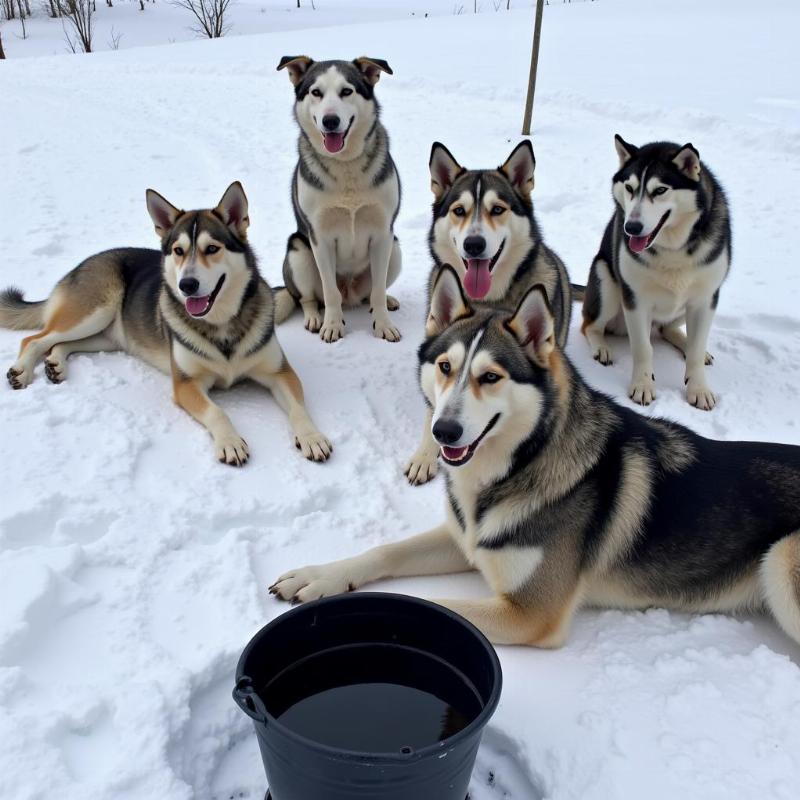Sled dogs are incredible athletes, enduring extreme conditions and pulling heavy loads across vast snowy landscapes. Their diet plays a crucial role in their performance and overall well-being. Finding the right dog food for sled dogs is essential to ensure they have the energy and stamina to thrive in their demanding environment. This means understanding their unique nutritional needs, which differ significantly from those of average pet dogs. Let’s explore how to choose the best dog food for these powerful canines.
Choosing the Best Dog Food for Sled Dogs
A typical pet dog’s diet focuses on maintaining a healthy weight and providing essential nutrients for everyday activities. However, sled dogs require a much higher calorie intake due to their intense physical exertion. Their diet must be rich in fats and proteins to fuel their muscles and provide sustained energy for long runs. Choosing the right dog food involves considering factors like activity level, weather conditions, and even the individual dog’s metabolism.
Key Nutritional Considerations for a Sled Dog’s Diet
- High-Fat Content: Fat is the primary energy source for sled dogs. Look for dog foods with a high percentage of animal-based fats like chicken fat or fish oil.
- Protein Power: Protein helps build and repair muscle tissue, essential for these working dogs. High-quality protein sources, such as meat and poultry, are ideal.
- Carbohydrates for Quick Energy: While fat is the primary fuel, carbohydrates provide readily available energy. Look for digestible carbohydrate sources like rice or sweet potatoes.
- Essential Vitamins and Minerals: Just like humans, sled dogs need a balanced intake of vitamins and minerals for overall health and immune function.
- Hydration is Key: Access to fresh, clean water is just as important as food, especially during intense activity. Dehydration can severely impact a sled dog’s performance and health.
Commercial vs. Homemade Dog Food for Sled Dogs
Many commercial dog food brands offer formulas specifically designed for working dogs or high-energy breeds. These are often a convenient and balanced option. However, some sled dog owners prefer to prepare homemade meals to have complete control over ingredients. Both approaches have their pros and cons. For homemade diets, consulting with a veterinary nutritionist is highly recommended to ensure the dog receives all the necessary nutrients.
Understanding Commercial Dog Food Options
When selecting commercial dog food for sled dogs, look for labels indicating “working dog,” “high-energy,” or “performance.” Check the guaranteed analysis to ensure sufficient levels of fat and protein. Reading reviews and consulting with your veterinarian can help you choose the best option for your dog.
Feeding Schedules and Portions for Sled Dogs
The amount of food a sled dog needs depends on factors like age, weight, activity level, and weather. During periods of intense training or racing, their caloric needs increase significantly. It’s important to monitor their weight and adjust portions accordingly. Overfeeding can lead to obesity, while underfeeding can result in poor performance and health problems.
Adjusting Diet Based on Activity Level
During periods of rest, sled dogs require less food. However, even during the off-season, they still need a diet that supports their muscle mass and overall health. A veterinarian can provide guidance on adjusting portion sizes based on your dog’s specific needs.
 Sled dogs resting after run
Sled dogs resting after run
Conclusion
Feeding sled dogs a proper diet is paramount to their well-being and performance. Whether you opt for commercial or homemade food, ensuring a balanced intake of high-quality protein, fats, carbohydrates, vitamins, and minerals is essential. By understanding their unique nutritional requirements and adjusting their diet based on their activity level, you can help your sled dogs thrive and enjoy long, healthy lives, ready to conquer any snowy trail.
FAQ
- What is the best type of fat for sled dogs? Animal-based fats, such as chicken fat and fish oil, are excellent sources of energy for sled dogs.
- How much should I feed my sled dog? The amount depends on factors like age, weight, and activity level. Consult your veterinarian for personalized recommendations.
- Can I feed my sled dog a regular dog food? Regular dog food may not meet the high caloric demands of a sled dog. Look for formulas specifically designed for working or high-energy breeds.
- Is it okay to give my sled dog supplements? Consult your vet before giving your dog any supplements to avoid potential imbalances or interactions with their food.
- How often should I feed my sled dog? Most adult sled dogs can be fed once or twice a day, but this can vary based on individual needs and training schedules.
- What are signs of malnutrition in a sled dog? Weight loss, lethargy, poor coat condition, and decreased performance can all be signs of malnutrition. Consult a veterinarian immediately if you notice these signs.
- How can I ensure my sled dog stays hydrated? Always provide access to fresh, clean water, especially during and after exercise.
Beautdogs.us is your premier resource for all things dog-related in the US. We offer expert advice on dog breeds, care, and products, catering to both novice and experienced dog owners. From understanding your dog’s nutritional needs to finding the perfect breed for your lifestyle, Beautdogs.us is committed to providing reliable, comprehensive, and engaging information to help you and your canine companion thrive. Contact us today for personalized guidance: Email: [email protected], Phone: +1 501-555-7529.